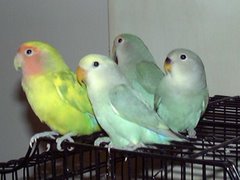Peach faced Lovebirds can over winter in an unheated shelter. There is no special food for breeding; just make sure dandelion, chickweed or lettuces are always available. Sprouting millet spray is especially good.
Usually peach faced Lovebirds males will be green. Brow, head, neck and throat are pink in color. Rump is bright blue in color. Beak- flesh colored. But females are bigger and paler in its head.
Peach-faced Lovebirds inhabit the dry areas on the fringes of deserts. But generally they will be very near to the watering place. During the off-season of breeding they will move in flocks making a loud 'tsick-tsick' noise. They are fond of all kinds of berries.
In wild the nesting behavior is noticed in decayed tree trunks or take over nests abandoned by the Colonial Sparrow or Mahali Weaver. All three species will live together without infighting.
Peach faced Lovebirds are always available through the trade at a very attractive price. Even imported birds are hardy.
A single peach faced lovebird is perfect fit for keeping in the house. It quickly becomes tame and attaches itself to its owner. However, only undertake to keep your Peach-faced Lovebird in the room with you if you can bear its harsh voice, which is hardly ever silent.
Peach-faced Lovebirds are ready to breed in all seasons in your garden, if they maintained in pairs. As you think sexing of Lovebirds is not an easy task. Females have their feet much farther apart than the males; they are also larger.
When the peach-faced Lovebirds are ready for breeding (6-9 months age), you can feel their pelvic bones. In males, they are virtually touching, whereas in females they are far apart- you can feel a small space between them.
Introduce several young in an aviary at one time to build a good breeding population. It is not at all advisable to introduce new birds in with an old pair as this always leads to fights.
Breeding
The female bird always picks up the small barks to form nest linings. They always prefer to carry the small barks of lime trees, birches or willow, are normally 6-8 cm long and carried five or seven at a time by the female to the nest.
The built up nest would be dome shaped. The entrance is at the top, on one side, only the rear wall behind being left fairly open. For this reason, it is good idea to make the back of your nest box removable for inspection during incubation.
The female peach-faced Lovebird lays 3-5 eggs and incubates it for twenty-two days. The young ones have born featherless and able to fly away from the nest within five or six weeks. The father feeds them for the next two weeks because the female lays eggs again straight away.
As soon as the young become independent, it is wise to remove from the flock, or otherwise the parents could attack them. Try to avoid more than three broods a year.
General Management
Peach-faced Lovebirds are not suitable for colony-system housing. It is best to keep single pairs in small aviaries 6x6x3 ft is suitable, although excellent results had been recorded in aviaries of half these dimensions.
Peach-faced Lovebirds are spiteful with other birds, and have noisy, penetrating calls. They are hardy birds and do best in unheated indoor accommodation when not breeding in the winter. As bottom line, peach-faced Lovebirds are not only perfect fit for your garden but also your aviary.








 Free Ads For Bloggers
Free Ads For Bloggers

